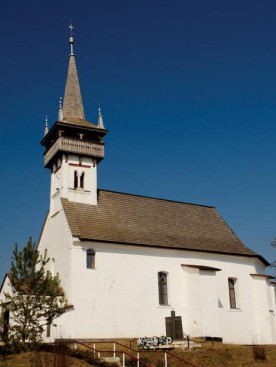The Calvinist Church –Palad’ KomarivtsiThis village located in the vicinity of Uzhhorod came into being in 1943 through the merger of two settlements: Palágy and Komoróc. Palágy village was given to the Aba clan at the end of the 13th century and remained in their possession for centuries. Master János of the Aba clan was already called Palágyi (‘from Palágy’). Furthermore, the parish of Palágy was mentioned in the register on the Papal Tenth in 1334. This church dedicated to Saint Michael was first mentioned in 1462, with the specification that it stood opposite to Mihály Palágyi’s manor house. Later, in the 16th century, the church belonged already to the Calvinists. After several smaller repairs, a comprehensive refurbishment followed in 1895, according to plans made by Ottó Sztehlo. The latest work commenced in 2006 with the support of the Teleki László Foundation: the tower and the total outer surface of the walls were restored, the shingles on the roof were replaced and the bells were electrified. Moreover, the exploration of the mural paintings also began. The church stands on a hill, in the centre of the village. This brick building has a single nave of the same width as the sanctuary. The latter is enclosed by three sides of an octagon, and its four corners are fortified with buttresses. In the southern wall of the nave, one can see the stone framing of the walled-up portal. A tower attaches to the western frontispiece; its top is decorated with a spire having an external gallery and four pinnacles. Twin windows and a cornice decorated with dog-teeth divide the tower. Two buttresses on the inside partially support the load represented by the tower, while carrying the western gallery as well. The inner space of the church is 16 metres long and 6 metres wide. The medieval church suffered previously only minor modifications, although the windows spanned by segmental arches were added during the Calvinist period. The most significant earlier restoration was performed in 1792 partly because the vaulted ceiling collapsed in 1650. The oldest parts of the church are the tower with the western gallery and the nave. A very similar solution of joining the tower and the gallery can bee seen in Csaroda’s church. The polygonal sanctuary was added later, in the 15th century. The mural paintings that have been uncovered since 2006 add a special value to the church. The scene on the southern wall of the nave depicts Christ standing on the gallery of hell and holding a flag with a cross in one hand, while extending his other hand towards a bearded man and a woman wearing a crown. The Saint Ladislaus legend is depicted on the balustrade of the western gallery. The scenes follow one another from the right to the left. A new wooden gallery built in front of the medieval gallery masks the upper parts of the scenes. Still, one can recognise king Saint Ladislaus’s armour and clothing, the figure of the Cuman warrior and the girl injuring the latter with a pole-ax. The mural paintings stem from the beginning of the 14th century, but represent even nowadays an exquisite decoration of the original church built by the Palágyi family a few decades before the creation of the paintings. |


















